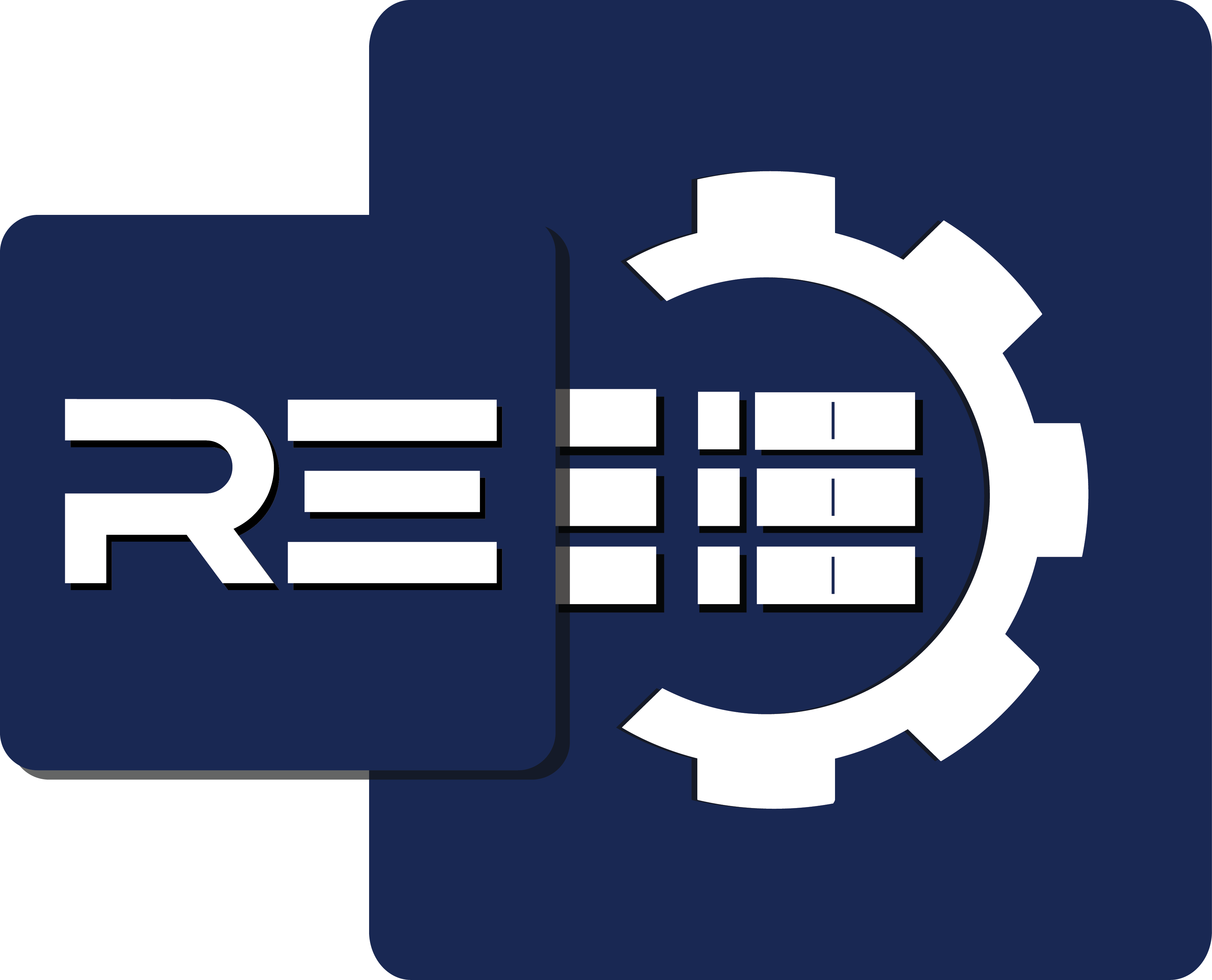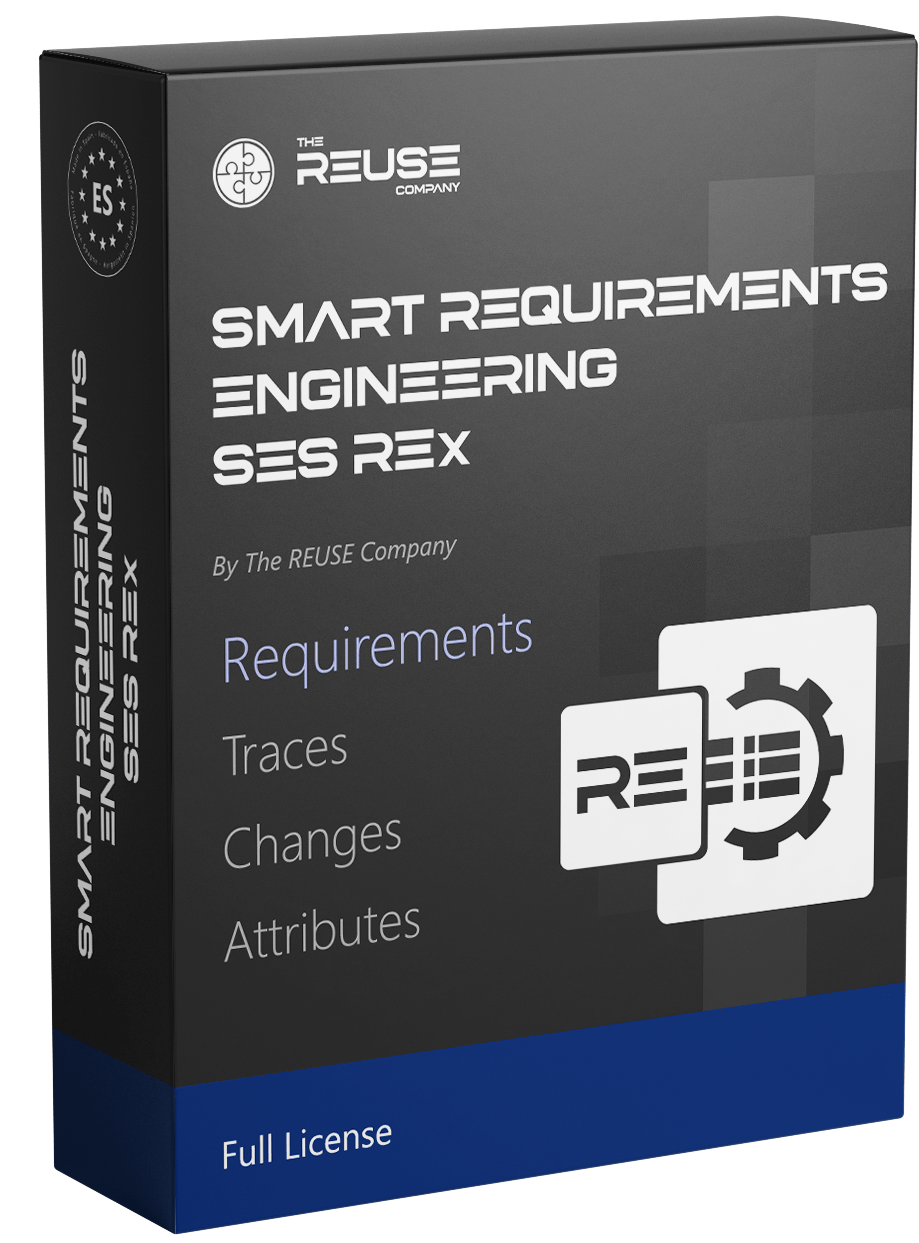SMART Requirements Engineering for MS Word - SES REx
A SMARTer way to engineer your requirements, integrating the process in a complete Systems Engineering digital thread.

Requirements Engineering Capabilities
Requirements Engineering (RE) is evolving rapidly. Modern views of the RE process include different activities covering from elicitation to validation in a very mature workflow. The REUSE Company presents its own proposal of the RE process.

The SES REx Software tool has been designed to tackle all the proposed activities in the process, giving a reusable approach to the customer. For example, the SES REx Word Edition, a complete Add-in for Microsoft Word, combines the superior authoring capabilities of Word with the engineering capabilities of The REUSE Company’s software tools. The result: a professional Requirements Engineering environment on top of the most known, used, and capable text authoring tool in the market.
This approach represents a flexible way of managing requirements in a well-known and easy-to-use environment, like e.g. MS Word, which has been boosted with the needed Requirements Engineering capabilities:
- identification of individual requirementswithin the document,
- professional assignment, and management of unique IDs,
- attributes management,
- traceability of requirements against any engineering item produced at any stage of the complete system life cycle (other Word documents, Excel, IBM DOORS, Siemens Polarion, Teamcenter, PTC windchill, …), MBSE tools (IBM Rhapsody, DS Cameo, EA, Capella), ALMs, PLMs, etc.
- baselining of the document, versioning of the requirements
- change control at the atomic level (requirement level),
- shared access for multiple users
- Quality assessment: Correctness, Consistency, and Completeness
- Requirements Verification and Validation
- Binding Requirements elements with model elements for automatic Updates
- Automatic Reporting system
Even more, by combining SES REx with SES HUBx (the Interoperability HUB implemented by The REUSE Company), it becomes possible to automate the digital thread including requirements in whatever transformation: Identifying requirements from standards, simulating requirements using simulation tools, converting requirements in models (MBSE) generating requirements from SysML, generating test cases from requirements, etc.
All those features convert your MS Word environment into a modern and complete Requirements Engineering environment, with comparable (if not better) features than the most modern RMS in the market.

Benefits of REx
Insightful
Combining the brilliant capabilities of MS Word (easy to use, accessible, formatting and styling, powerful editing…) together with the Requirements Engineering capabilities of the Add-in provides the best of both worlds.
Interoperability
Through the SES HUBx application, by means of its Interoperability HUB, your requirements document will always be connected to the rest of assets along the systems engineering life cycle.
Cost saving
Automating peer-reviewing and quality analysis can reduce rework (and consequently costs) caused by flaws in your system engineering items at all levels.
Features of REx
Democratization of the requirements management process
Managing requirements in a professional way, has never been that easy and cheap. Microsoft Word is one of the most widely used tools, and is clearly not intended to be a requirements engineering tool, but wisely boosted with a smart add-in like the SES REx, it will allow any user to perform advanced tasks related to the requirements engineering discipline effortlessly.
Automatization of the technical management processes
Just by connecting your Word documents to any other connection offered by other of our products: SES TMx, several critical activities are enabled:
- Traceability management: to or from any other engineering item connected to REx
- Quality Management: selection of quality rules like those in the INCOSE GtWR, assessment of your items, writing assistance, quality reports…
- V&V Management: where the requirements in your documents become the source of the verification actions of your System of Interest.
Advanced parsing mechanism
A huge variety of document structures can be analyzed by the advanced parser of the REx Add-in for MS Word allowing the identification, with a click of a button, of the relevant pieces of information included in your MS Word or PDF documents. This parser identifies the content of the document (a sentence, a paragraph, or several paragraphs) according to different identification strategies, provides a unique ID to each item, and synchronizes two different views in the document:
- The typical Documental View managed by MS Word
- The so-called Engineering View that enables all the Requirements
Documental view vs engineering view
The ribbon implemented by the SES REx Add-in for MS Word allows easy integration of any of your Word documents into the Repository implemented by the SES Suite.
Once the document is connected, the typical content of an MS Word document is now extended with the Engineering View. This view will show all the content that has been parsed or a series of requirements that the user can create just by interacting with the buttons of the SES ribbon in Word.
Both, the documental view and the engineering view, will always remain synchronized. Select an element in the engineering view and
the documental view will scroll to show the items in the document, surrounded by a border to explicit the limits of your item. Edit the element in the document and the change will be automatically replicated in the engineering view. Add a new element in the engineering view and a new block will be created in your document, with the same ID and content given in the engineering view. Remove an item from any of the views, and the element will be instantaneously marked as removed also in the other view.
And, what is more interesting, the Add-in prevents the IDs from being modified. Once an ID is assigned, this ID is fixed, not modifiable, and unique all along the document.
Operations in the engineering view
Most of the advanced requirements engineering capabilities take place in the Engineering View. This includes operations such as attribute management, change management, baselining, versions, traceability management, quality analysis, link to verification and validation activities, and report generation…
These capabilities of the Engineering View are highly customizable. The user can select which attributes shall be displayed as columns in the view. Columns allow for sorting and filtering. Operations such as adding, editing, and removing are shown with different colors in the corresponding column for the items involved. Furthermore, the default engineering view can be transformed into a series of subsidiary views: quality view, traceability view, V&V view, or documental view.
The SES REx Add-in for MS Word makes all these operations possible. Just by saving your changes, either with the default Save button of MS Word or with the Save option on top of the Engineering View, all these changes, attributes, and traces will be stored within the repository of the SES Suite. From this moment on, the engineering content of the document can be accessed either from within MS Word, or at any of the SES Suite desktop applications.
Traceability Management
As soon as a Word document is connected to the Integration HUB it is now considered as one of the potential sources for a traceability module in SES ENGINEERING Studio. The MS Word Add-in includes the possibility to create traceability modules between your current document and any other content of the HUB (other requirements documents, requirements modules in an external Requirements Management tool, model elements into an MBSE tool, items in an Excel worksheet…
From the connectors view implemented by the Add-in, you can open, within MS Word, the Engineering View of any other connected source (requirements, models…). Now the Traceability View is all you need to establish new traces, remove traces, check for orphan elements, and display an impact analysis. There is no need to open the other involved tool or copy IDs.
Change Management
This is another mandatory capability in any Requirements Engineering Tool. Once the individual items have been identified, the change control is now done at individual elements, even within an MS Word document.
Every time you save a document, a new version will be created for every element with pending modifications. Users can also force new versions whenever they want. The changing track can show you the content of any of those old versions, compare it with the current version, and revert to a previous one.
A baseline of the full document can also be generated on demand. This baseline can be seen as a kind of snapshot, including all the elements identified at the moment of the baseline, their current version, and current values of attributes. Document baselines can also be displayed with the baseline browser which highlights the differences between the current baseline and a previous one, and permits the revert operation.
Attribute Management
A default requirements document created with the REx Add-in comes with the most typical attributes for a requirement. However, other additional attributes can be easily created with the help of the attribute wizard.
Once your attribute schema has been defined for a given document, you can choose which of those attributes are to be shown in the different views that you can create for your document.
Access Control
A requirements document managed with the SES Add-in can be stored either locally, or virtually in the repository.
Storing documents virtually in the repository enables the access control operations that every professional requirements engineering tool shall implement. Users can access the document, read-only versus full access, prevent certain operations to be executed by specific users or roles…
Requirements Quality
Writing high-quality requirements has never been this easy. As a core element of the Systems Engineering Suite, checking whether your requirements follow the rules assigned to your document through SES ENGINEERING Studio is as easy as swapping to the Quality View.
Having a quality analysis in real-time, and having writing assistance based on textual patterns is also included in the Authoring Tool implemented within the REx Add-in for MS Word.

